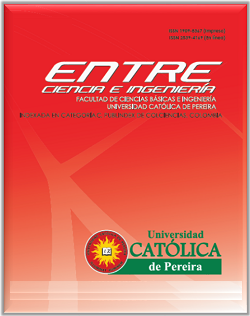Physical and chemical differences of the supplemented soil with electric batteries
DOI:
https://doi.org/10.31908/19098367.1164Keywords:
electric batteries, organic matter, substrate, nitrogenAbstract
There are peasant practices in the department of Caquetá and testimonies of people in the city of Florence that involve the use of electric batteries as the basis of organic fertilizer for plants. Faced with the hypothesis that electric batteries can contribute to the healthy development of a plant, the objective of the present study was to evaluate the incidence of electric batteries in the physical and chemical properties of a soil sample destined to plant beans. The experiment consisted of a completely randomized design (DCA) with a 1 x 4 factorial arrangement, where factor A corresponds to beans, and factor B corresponds to the variety of electric batteries (generic and alkaline) with three repetitions. In each treatment, it was determined: pH, exchangeable acidity (A.I.), organic carbon (C.O), ashes, color, and conductivity. The study showed that the addition of electric batteries to the soil favors the absorption of solar energy, making the average soil temperature tend to be higher, which would tend to promote rapid germination in the seeds, positive aspect in the germination stage of this. However, it can affect the low release of nitrogen to the soil, in its post-growth phases.
References
Programa de Naciones Unidas para el Medio Ambiente. Avances y progresos científicos en nuestro cambiante medio ambiente. http://www.unep.org/yearbook/2010/PDF/UNEP_ES_2010_low.pdf. 2010.
Fernández, A. Basura electrónica, un grave problema ambiental. http://www.consumer.es/web/es/medio_ambiente/urbano/2014/03/10/219489.php. 2014.
Díaz, A. Los productores y comercializadores de pilas deberán tener un Sistema de Recolección Selectiva y Gestión Ambiental. http://www.activolegal.com/web/index.php/noticias/actualidad/414-noticia180313n1. 2013.
Soto. R. Diagnóstico de la generación de RAEE provenientes del uso de computadores en el sector institucional de Bogotá D.C. (Colombia). Residuos: Revista Técnica. 16 (88), 118-125, 2006.
Martínez, A. Análisis de la generación y disposición de residuos de aparatos eléctricos y electrónicos RAEE'S domiciliarios en el municipio de Yopal (Casanare). Universidad de Manizales. Tesis de maestría. 2015.
Castro, J. and Díaz, M. La contaminación por pilas y baterías en México. Instituto Nacional de Ecología. http://www2.inecc.gob.mx/publicaciones/libros/438/cap5.html. 2007.
Asociación Nacional de Industriales. Investigaciones complementarias. http://www.andi.com.co/pages/proyectos_paginas/contenido.aspx?pro_id=177&IdConsec=1427&clase=8&Id=20&Tipo=2. 2013.
Robinson, B. E-waste: An assessment of global production and environmental impacts. Science of The Total Environment. 408 (2), 183-191. 2009.
Olivetti, E., Gregory, J. and Kirchain, R. Life cycle impacts of alkaline batteries with a focus on end of life. http://www.epbaeurope.net/documents/NEMA_alkalinelca2011.pdf. 2011.
Rydha, C. Life cycle inventory of recycling portable nickel–cadmium batteries. Resources, Conservation and Recycling. 34k(4), 289–309. 2002.
Shen, C., Chen, Y., Huang, S., Wang, Z., Qiao, M., Xu, Y., Setty, K., Zhang, J., Zhu, Y., Lin, Q. Dioxin-like compounds in agricultural soils near e-waste recycling sites from Taizhou area, China: Chemical and bioanalytical characterization. Environment International. 35 (1), 50-55. 2009.
Instituto Geográfico Agustín Codazzi. 1973. Métodos analíticos de laboratorio da suelos. Tercera edición. Bogotá.
Chapman, H. D. Cation Exchange capacity. In: C. A. Black (ed.). Methods of analysis. Part. 2. Agronomy 9. American Society of Agronomy. Madison, Wisconsin. pp. 891-901. 1965.
Jackson M. L. Análisis químico de suelos. Trad. al español por M. J. Beltrán. 3ª. edición. Omega. Barcelona, España. 1976.
Allison, L.E. Organic carbon. In: CA Black (ed). Methods of Soil Analysis (Part 2) Chemical and Microbiological Properties. Publisher: America Society of Agronomy Inc., Madison, Wisconsin, USA. Pp: 1367-1378, 1965.
Richards L A. Diagnóstico y rehabilitación de suelos salinos y sódicos. 6ª. edición. Departamento de Agricultura de Estados Unidos de América. Limusa. México, D.F. 1990.
Moreno, M. J., Belén, D.R., Sánchez, M.P., Viloria, M., García, D. “Evaluación de la actividad antioxidante de extractos de flavonoides de cáscara de naranja en el aceite de soja desodorizado”. Interciencia. Vol. 9. no. 29, p.p. 532-538, septiembre de 2004.








 Revista Entre Ciencia e Ingeniería
Revista Entre Ciencia e Ingeniería .png) entrecei@ucp.edu.co
entrecei@ucp.edu.co.png) ISSN (Impreso) 1909-8367 - ISSN (En Línea) 2539-4169
ISSN (Impreso) 1909-8367 - ISSN (En Línea) 2539-4169 Attribution-NonCommercial 4.0 International (CC By-NC 4.0)
Attribution-NonCommercial 4.0 International (CC By-NC 4.0)
.png) Carrera 21 No. 49-95 Av. de las Américas, Pereira, Risaralda, Colombia
Carrera 21 No. 49-95 Av. de las Américas, Pereira, Risaralda, Colombia